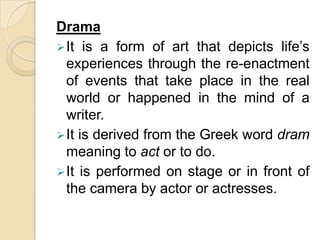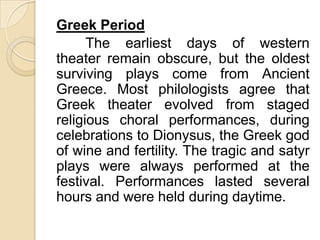Chapter 7 drama
- 1. CHAPTER 7 DRAMA PREPARED BY: ROGER B. TRAJANO INSTRUCTOR
- 2. Drama It is a form of art that depicts life’s experiences through the re-enactment of events that take place in the real world or happened in the mind of a writer. It is derived from the Greek word dram meaning to act or to do. It is performed on stage or in front of the camera by actor or actresses.
- 3. ELEMENTS Literary Elements Are those elements of drama as a literary art.
- 4. Direction The director is the overall in charge of the dramatic performance. He instruct the actors and all the people involved in the production from the production assistants to the cameramen, props men, effects men, designers, etc.
- 5. Acting The members of the cast perform the roles assigned to them by the director. They read the script, memorize their lines, follow the instructions given by the director, and give justice to their assigned roles.
- 6. Editing The editor sequences the scenes to be presented in such a way that they make up a coherent whole. Like a newspaper editor who deletes unnecessary words from a news article, he takes out unnecessary scenes, particularly the obscene and offensive one.
- 7. Set Design The set designer does the layout of the set. He determines what to place as backdrop and what to put on stage.
- 8. Cinematography It is the person who takes charge of the photography. He looks for a location that fits the story and, with the aid of the cameramen, shoot the scene forming part of the drama.
- 9. Production Design Similar to the set designer is tasked to do the overall design for a drama to be shown on the small screen or the wide screen. A production designer has a bigger responsibility because his work is not only limited to a studio, a room, or the stage but it covers an area as wide as a small community or large province.
- 10. Costume Design The costume designer creates the clothes to be worn by the actor and the actresses. Akin to a fashion designer who comes up with a fashionable clothes appealing to his target market, he sees to it that the costumes suits the characters to be portrayed by the performers.
- 11. Make-Up The make-up artist beautifies or uglifies the actors and actresses based on the role they portray.
- 12. Properties The properties are the things which the actor and the actresses carry or bring with them as they perform on stage or in front of the camera in order to establish their characters.
- 13. Light/Lighting Effects The lights man is in charge of determining the amount and the sources of light needed to make scenes realistic and credible.
- 14. Sound Effects The sound effects man is in charge of determining the amount and the sources of the sounds needed to make the scenes realistic and credible.
- 15. Visual Effects The visual effects man is in charge of producing those sights that are not usually captured by the camera in order to make the scenes effective, exciting, and appealing to the viewers.
- 16. Theme Song The theme song is the song composed to represent the theme or the subject matter of the drama.
- 17. Musical Score The theme song is not the only song played in a drama, whether it is a comedy, a tragedy, a melodrama, or another genre. There are other song played to set the mood, to excite the audience, or keep the viewers glued to their seats.
- 18. Story The story is one of the most important aspects of a play for without it, there won’t be any production. The story maybe an adaptation or an original narrative. The story is the brainchild of the writer of the original story or of the author of the novel, short story, epic poetry, or any literary piece turned into play.
- 19. MEDIUMS Stage Play It is a drama performed on stage. The dramatic performers perform live before an audience.
- 20. Radio Play It is a drama aired over the radio. The dramatic performers perform live in the studio but not before an audience.
- 21. Television Play It is a drama shown on television. The dramatic performers tape the play days before it is presented to the public.
- 22. Movie or Film It is a drama shown on the wide screen. The dramatic performers shoot the film months before it is presented to the public.
- 23. HISTORY Prehistoric Period The earliest recorded theatrical event dates back to 2000 B.C. with the passion plays of Ancient Egypt. The story of the god Osiris was performed annually at festivals throughout the civilization, marking the known beginning of a long relationship between theater and religion.
- 24. Greek Period The earliest days of western theater remain obscure, but the oldest surviving plays come from Ancient Greece. Most philologists agree that Greek theater evolved from staged religious choral performances, during celebrations to Dionysus, the Greek god of wine and fertility. The tragic and satyr plays were always performed at the festival. Performances lasted several hours and were held during daytime.
- 25. Roman Period Ancient Roman theater was heavily influenced by the Greek tradition. The Roman dramatists tended to adopt and translate from the Greek as writers in other literary genres did. Compared to Greek theater, Roman theater was less influenced by religion and was more aesthetic appeal.
- 26. Medieval Period In the Middle Ages, theater was reborn as liturgical dramas, written in Latin and dealing with Bible Stories and performed by priests or church members. Then came vernacular drama spoken in the vulgate this was more elaborate series of one-act dramas enacted in town squares or oter parts of the city. There were three types of vernacular dramas: mystery or cycle plays, miracle plays, and Secular plays.
- 27. Renaissance Period Theatrical activities, particularly comedies, flourished in Italy, England, and Spain during the 16th and early 17th century. During the early part of this period was simple; however, at the latter part of this period, more elaborate theaters were constructed to satisfy the needs of the actors and the viewers.
- 28. Modern Period During this period, drama was not only performed live on stage but also enjoyed through the mediums of radio, television, and cinema. Stage performers became television and movie actors to gain more popularity since television and film have wider audiences compared to stage; moreover, they received a higher pay.
- 29. The End Thank You for Listening































